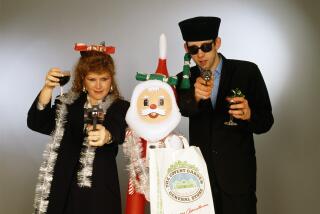Upriver From Time’s Waterfall : THE LAST FINE TIME <i> By Verlyn Klinkenborg (Alfred A. Knopf: $19.95; 210 pp.)</i>
- Share via
It is a little like the way Dylan Thomas begins “Under Milk Wood.” Verlyn Klinkenborg hovers over his town, watching. What he watches is not the wandering dreams of a Captain Cat but the hushed beginning of one of the formidable snows in Buffalo, N.Y.
There is the apparatus of TV weather maps and snow-tire advisories. “The weather is a subject well covered here in the Niagara Frontier,” the author writes. With that “Frontier,” we are out of the apparatus and among picket fires circled against the northern wilderness. A mood is being set:
” . . . and the mood in Buffalo begins as a rumor. The elderly put their heads together and fret: This is the time of year when parking lots are like bathtubs without handholds or rubber safety mats. This is brittle-hip season. Cashiers at the cavernous Bell’s and Wegman’s supermarkets around town swap weather gossip with their customers over the bar-code readers at every checkout aisle, over the toaster waffles, the low-salt Swiss cheese, the family-size toothpaste in the pump dispenser, the $243.61 of groceries minus 10 minutes of coupons pulled one by one from a soft-sided coupon file.”
It is not yuppie America that Klinkenborg is invoking with that outsized toothpaste, the huge yet patently modest grocery bill, the coupons. It is a different urban America, grittier and with a long history. The author summons it up place by place; he gives it a voice:
“The first flake appears and vanishes like a virtual particle in the mind of a physicist. It might have appeared high over Our Lady of Victory Basilica in Lackawanna or above the Buffalo Lighthouse at the Coast Guard base on Lake Erie; over Martin Luther King Jr. Park or in the vicinity of the black-tongued bison at the Buffalo Zoo. It might have appeared anywhere. But suddenly without seeming to begin, the sky is full of real particles falling so slowly that they appear to stand, wavering in air. Suddenly the mood shifts. Snow is falling. Well. It is a relief, somehow. It is an event. It is something. It could be worse.”
With these first few pages of poetic sweeps and canny details, Klinkenborg gives us an inkling of what he is going to tell and how he is going to tell it. He writes a history of the community America set up in and against its geography; and of the rise and decay of perhaps the most astonishing form of that community: the American industrial city.
He develops the history in all kinds of ways. He uses statistics, maps, old commercial directories and studies of the immigrant communities before and after they came to America. He uses place names, brand names, turn-of-the-century newspaper ads and Chamber of Commerce handouts. He ruminates on a large scale, describes the down-to-the-bolt operations of a 1920s railroad shunting yard, and conjures up a hallucinatory play of visions and associations.
Running through and sustaining it all is the 50-year history of a Polish-American neighborhood bar and restaurant, property of the Wenzeks, father and son. What they have done, in generational succession, to survive, adapt, prosper and finally endure, gives life to the author’s big themes. The big themes give power to the story of their lives. Klinkenborg’s writing, compounded by an agile passion to know what he can, and to dream what he cannot, gives a good deal of magic to both.
For the sake of minimal clarity, a brief review must separate what “The Last Fine Time” so intricately knots together. It is the special quality of the book that the daily moves of Thomas and Eddie Wenzek through their East Buffalo world are set almost sentence by sentence alongside accounts of life in Polish Galicia, the early settlement of Buffalo, and the details of its industrial growth and decline.
Thomas, who retired in 1947, would have fried brains and scrambled eggs for breakfast, and put down Liederkranz and onion sandwiches for lunch. “Tom likes foodstuffs with a miasma,” the author writes. On pork nights at the restaurant, he would carve up a whole roast pig; Eddie, modernizing and Americanizing the place and changing its name from the stolid Old World “Thomas Wenzek Restaurant” to “George and Eddie’s,” switched to the handier pork loin. Along with Tom’s brawny solidity, we get the iron-and-steel heaviness of America’s industrial age. Automobiles were metal fortresses, and 363 trains arrived each day at the city’s five railroad terminals.
Buffalo was founded at the beginning of the 19th Century. Its location was ideal for a country beginning to look West: at the eastern end of Lake Erie and the chain of lakes that extended halfway across the continent. The Erie Canal would make it even more desirable. Buffalo was now astride a great waterway that connected the Atlantic ports and the industry of the East to the farms, the wheat and iron of the Midwest and the northern-tier states.
By the end of the century, Buffalo was a giant of heavy industry and metal fabrication, of transportation, and of trade. Its brawn was supplied first by German immigrants and then by Poles. Klinkenborg writes of these developments in sufficient detail, but the detail turns joyful and dense with his real point of departure, i.e. the arrival of Thomas Wenzek from Galicia at the start of the century.
It was the wave’s crest and, like any such crest, the undertow that would collapse it was beginning to run. Until the 1950s, Buffalo’s heavy industry--weakened during the Depression but given new life by World War II and the subsequent recovery--seemed spectacular. In fact, as Klinkenborg shows, it was losing ground.
In part, his book is about the passing of industrial America; of its solidity, its stolidity, its hard work and its narrowness. The author is not sentimental about it--the gritty world he writes of had a full measure of hardship--but he finds nothing to replace its energy except a gentling, an ease that, by the 1960s, had largely moved out to the suburbs; and that as of today has its own future in doubt.
Lack of sentimentality does not mean lack of love. A railroad yard may be hard to love; so, for a modern sophisticate, may be the crudely sweet landscapes painted on the back of Thomas Wenzek’s bar; so may be the 1950s “improvements” made by Eddie--dinner dancing, fish-fry suppers, Manhattans and middle-class gentility instead of working-class roughness. But people can be loved, and the love extend to the world they lived and struggled in.
Klinkenborg qualifies as author of this glowing and complex story by virtue of his gifts as a writer, his painstaking reporting and research; and by the fact that he married Eddie Wenzek’s daughter. He is inside and outside at the same time; his shuttle zips back and forth, weaving a precious fabric.
The snowstorm that starts off the book was not a random snowstorm. The author was driving through it on one of many visits to Eddie, now in his 70s, retired and full of life. From such visits came the details for the story of the Wenzeks’ bar and restaurant, and the tight-knit neighborhood it served as community center, feasting place, theater and confessional. Klinkenborg sits us there under the coarse but warm reign of Tom, and Eddie’s smoother, more up-to-date but equally warm tutelage. We are led out to explore the changing city; we come back in for more stories.
Some of the stories are about Niagara Falls, a few miles downriver. Occasionally, people fall into the river and are swept down and over. Eddie’s stories, though, concern people’s lives--a good fortune, a slip, a disaster. Klinkenborg fashions his concentric accounts of the bar, Buffalo, and America, as places upriver from time’s waterfall; sooner or later to topple and be carried over.
Eddie, meanwhile, is chipper. He welcomes the author in out of the weather, and pours him a hefty Scotch.
“As they drink, Eddie leans toward a story. It is his natural posture. He sets his glass down, empty, and this is how he starts. He opens his mouth and these are the words he uses:
“ ‘Say you’re me.’ ”
The author has, and we do.
More to Read
Sign up for The Wild
We’ll help you find the best places to hike, bike and run, as well as the perfect silent spots for meditation and yoga.
You may occasionally receive promotional content from the Los Angeles Times.






